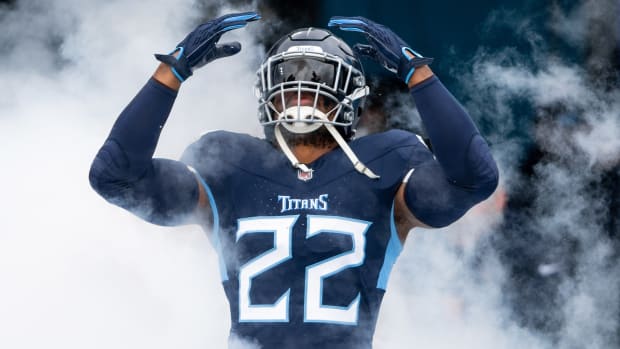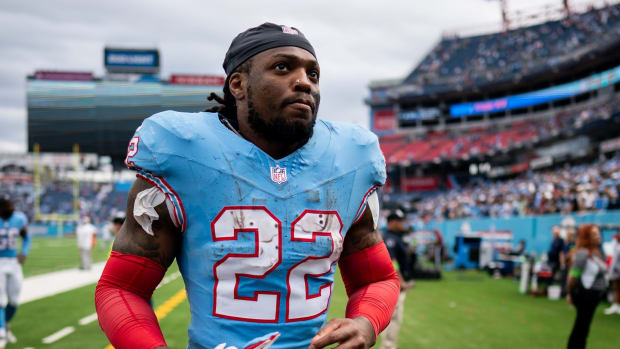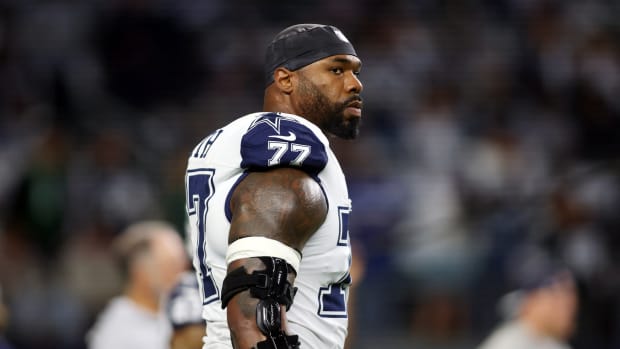The Robert Woods Trade: Reasons for Optimism, Pessimism
NASHVILLE – Underestimate the inclination of Tennessee Titans general manager Jon Robinson to make big moves at your own peril.
His acquisition Saturday of wide receiver Robert Woods from the Los Angeles Rams – in exchange for a 2023 sixth-round draft pick – is but the latest high-profile addition in a long line of offseason deals over the years.
Some of the bigger names Robinson has previously added – via free agency or trade – since taking over in 2016 include running back DeMarco Murray, cornerbacks Logan Ryan and Malcolm Butler, safety Kenny Vaccaro, quarterback Ryan Tannehill, guard Rodger Saffold; edge rushers Jadeveon Clowney, Vic Beasley and Bud Dupree, wide receiver Julio Jones, and defensive lineman Denico Autry.
Some of those moves – obviously – worked much better than others.
How will the trade for Woods be looked at in time?
Here are five reasons for Titans fans to be excited about the team’s latest big addition, three reasons for caution.
GET EXCITED
Consistency and production: Before getting hurt last season, Woods was on pace for 85 catches, along with 1,050 yards and eight touchdowns. Those numbers look a lot like Woods from 2018 (86 catches, 1,219 yards and six TDs), 2019 (90 catches, 1,134 yards, two TDs) and 2020 (90 catches, 936 catches and six touchdowns).
In other words, it didn’t appear the 29-year-old was slowing because of age prior to the injury.
A couple other stats to support that argument: Woods was on pace for 15 catches of 20-plus yards last season, which would have been the second-highest total of his career. In addition, quarterbacks throwing to Woods last season posted a quarterback rating of 107.9, the second-highest figure of his career
Complementary piece: A.J. Brown’s numbers were good last year – 63 catches for 869 yards (13.8-yard average) and five touchdowns – but not as good as in his Pro Bowl season of 2020. Injuries played a big role in that, as Brown was limited to 604 offensive snaps in 2021, down from 760 in 2021.
But even when healthy, Brown wasn’t always as impactful as he had been the previous season. One theory is that he received so much attention from opposing defenses.
The Titans hoped Jones would provide the kind of complement that would free up Brown in 2021, but injuries limited him to just 10 games and 393 snaps. Contrast that with 2020, when Corey Davis provided a much more consistent threat opposite Brown, playing 14 games and 719 snaps.
If Woods continues to be as productive as he was pre-injury, defenses will have to keep their eyes on him – as well as Brown. And if the Titans add a top receiver in the draft, it should offer Tannehill quite the buffet in 2022.
Run-blocking ability: We all know what a premium the Titans put on run-blocking, understandable for a team that has for years been built around Derrick Henry. The Titans ran the ball on 48.8 percent of plays last season (second in the NFL), and that was with Henry limited to just eight regular-season games.
So, the fact that Woods is one of the best run-blocking receivers in the NFL certainly must have been attractive to the Titans.
He earned a Pro Football Focus run-blocking grade of 84.9 percent last season, tops among NFL receivers with at least 100 run-blocking opportunities. Woods has posted a run-block grade of better than 75.0 in four of his past five seasons, a trait that did not go unrecognized by coach Mike Vrabel in the lead-up to the Titans’ game against the Rams in 2021.
“I would say that (Woods and Cooper Kupp) are two of the best blocking wide receivers in the league,” Vrabel said. “It has been impressive just to watch them not only with their route craft and what they do, but the commitment they make to blocking players. I am not talking just DBs. They are trying to block outside linebackers -- cut them off or do whatever they need to do in their offense.”
Versatility: The Titans are big on versatility at the wide-receiver position, evidenced by the high praise doled out to Nick Westbrook-Ikhine for being able to step into any spot last season.
Woods has shown a similar ability to play both inside and outside.
In his nine games last season, 152 of Woods’ 340 pass-play snaps came from the slot (44.7 percent), while 184 were on the outside (54.1 percent). We shouldn’t ignore Woods’ running ability either, as he’s totaled 74 career carries for 507 yards (6.9-yard average) and five touchdowns.
Veteran leadership: Prior to the Woods trade, Brown had been the receiver with the most Titans experience on the roster – and he’s played only three seasons in the league. Westbrook-Ikhine has two years under his belt, while others like Dez Fitzpatrick, Racey McMath, Cody Hollister, Mason Kinsey and Josh Malone have very little experience at all.
That changes in a big way with Woods, who has played nine NFL seasons – four in Buffalo, five with the Rams.
But Woods has done more than just catch passes during his NFL tenure. He has, from all accounts, turned into quite a teammate and leader – serving as one of the Rams’ captains for the past two seasons.
Here’s what Rams coach Sean McVay said about Woods following the ACL injury:
“You're sick for Robert,” McVay said at the time. “He's epitomized everything that has been right about this place. Such a great competitor, such a tough player, such a great football player and a great person. It's so unfortunate.”
Woods should serve as an invaluable mentor to Brown and the other young receivers.
Price was right: The Titans gave up some good draft capital last season when they acquired Jones, surrendering a 2022 second-round pick and a 2023 fourth-round pick.
But it was much different this time around. The Titans gave up only the 2023 sixth-rounder – because of Woods’ injury status and the fact the Rams were trying to unload him for salary-cap space.
So, if for some reason things don’t work out with Woods, the Titans wouldn’t have hurt themselves nearly as badly in the draft. Sixth-round picks aren’t counted on for much of an impact. Linebacker David Long is the only sixth-round pick under Robinson who’s excelled, while the production of others – wide receiver Racey McMath, safety Brady Breeze, quarterback Luke Falk, offensive lineman Corey Levin and offensive lineman Sebastian Tretola – has been minimal (at best) to date.
REMAIN CAUTIOUS
The age issue: The good news is that Woods, who turns 30 next month, is three years younger than Julio Jones. But the fact remains that high-impact receivers 30 years of age or older are few and far between in the NFL these days.
Only one receiver 30 or older – Buffalo’s Cole Beasley (82 receptions) – finished among the NFL’s top 25 in catches in 2021, and only four (Minnesota’s Adam Thielen, Jacksonville’s Marvin Jones and Arizona’s A.J. Green were the other three) finished in the top 50.
Zero receivers 30 or older finished among the NFL’s top 25 in receiving yards last season, and only five – Green, Marvin Jones, Thielen, Beasley and Buffalo’s Emmanuel Sanders – finished among the league’s top 50.
Only two receivers 30 or older – Thielen (10 touchdown catches) and Green Bay’s Randall Cobb (five TD catches) – caught as many as five touchdown passes last season.
The injury: Woods had been durable up until last year’s injury, having played in 56 of a possible 57 games since the start of the 2018 regular season. But ACL injuries at the wide receiver position, especially for wide receivers in the 30-year-old range, can’t just be overlooked.
Odell Beckham Jr., for instance, sustained his first torn ACL in 2020 as he approached his 28th birthday. Beckham did return last season and was back to playing at a high level in the postseason, but then tore the same ACL again in the Super Bowl. Going back a few years for another player in the same age range, former Jacksonville receiver Cecil Shorts tore his ACL (and suffered a dislocated kneecap) at age 29 in 2016. He never returned to the game after posting 229 catches in his career.
On a brighter note, former Green Bay wide receiver Jordy Nelson tore his ACL at age 30 in training camp in 2015. He missed all of 2015 but bounced back with 97 catches for 1,257 yards and 14 touchdowns in 2016.
At the very least, though, Woods’ injury – sustained last November – seems likely to slow his offseason and perhaps part of next season as well. That was the case with Dupree, who didn’t play his best football until the end of 2021 after suffering a late-season ACL injury in 2020.
Salary cap: At this point, Woods is scheduled to count $13.5 million against the 2022 salary cap. That may change if the Titans restructure Woods’ deal, or if it’s eventually determined the Rams will pay a portion of that amount.
But if the $13.5 million hit remains, that’s a pretty big figure – sixth-highest on the Titans behind Tannehill, Dupree, Kevin Byard, Henry and Taylor Lewan. Does it make sense to add that kind of salary when the team just released Jones in part for economic reasons, as Jones was scheduled to count $14.3 million against the cap?
Per OverTheCap, the Titans were $6.8 million over the cap as of Monday morning, and that’s before the contracts of some smaller free-agent additions were even factored into the equation.
On the other hand, If Woods’ contract does remain unchanged, the Titans could cut him next season -- with no dead-cap fee – if things didn’t work out.







